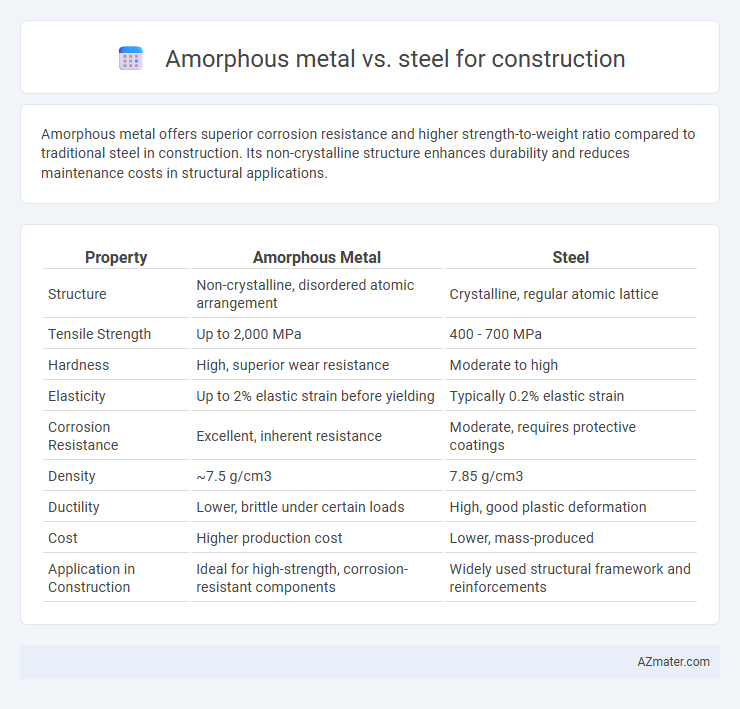Amorphous metal offers superior corrosion resistance and higher strength-to-weight ratio compared to traditional steel in construction. Its non-crystalline structure enhances durability and reduces maintenance costs in structural applications.
Table of Comparison
| Property | Amorphous Metal | Steel |
|---|---|---|
| Structure | Non-crystalline, disordered atomic arrangement | Crystalline, regular atomic lattice |
| Tensile Strength | Up to 2,000 MPa | 400 - 700 MPa |
| Hardness | High, superior wear resistance | Moderate to high |
| Elasticity | Up to 2% elastic strain before yielding | Typically 0.2% elastic strain |
| Corrosion Resistance | Excellent, inherent resistance | Moderate, requires protective coatings |
| Density | ~7.5 g/cm3 | 7.85 g/cm3 |
| Ductility | Lower, brittle under certain loads | High, good plastic deformation |
| Cost | Higher production cost | Lower, mass-produced |
| Application in Construction | Ideal for high-strength, corrosion-resistant components | Widely used structural framework and reinforcements |
Introduction to Amorphous Metal and Steel in Construction
Amorphous metals, also known as metallic glasses, exhibit non-crystalline atomic structures that provide exceptional strength, corrosion resistance, and elasticity compared to traditional crystalline steel. Steel remains the dominant material in construction due to its well-established manufacturing processes, affordability, and ductility, making it ideal for frameworks and reinforcement. The unique properties of amorphous metals offer potential advancements in structural performance, particularly in reducing weight and enhancing durability for specialized construction applications.
Composition and Structure Differences
Amorphous metal, also known as metallic glass, features a non-crystalline, disordered atomic structure that contrasts sharply with the well-ordered crystalline lattice of traditional steel. The composition of amorphous metals typically involves rapidly cooled alloys such as zirconium, iron, or magnesium-based blends to prevent crystal formation, enhancing strength and corrosion resistance. Steel, composed primarily of iron with carbon and other elements, relies on its crystalline grain boundaries for mechanical properties but is more susceptible to deformation and corrosion compared to amorphous metals.
Mechanical Properties Comparison
Amorphous metals exhibit significantly higher tensile strength and hardness compared to conventional steel, often exceeding steel's strength by up to 2-3 times due to their non-crystalline atomic structure. Their superior elasticity and resistance to wear make them ideal for applications requiring high mechanical performance and durability under stress. However, steel maintains better ductility and toughness, providing greater impact resistance and flexibility in construction scenarios where deformation without fracture is critical.
Corrosion Resistance and Durability
Amorphous metals exhibit superior corrosion resistance compared to traditional steel due to their non-crystalline atomic structure, which minimizes grain boundaries and reduces sites for corrosion initiation. This unique structure also enhances durability by providing higher strength and resistance to wear and fatigue under harsh environmental conditions. Steel, while versatile and widely used, is more prone to rust and degradation over time, especially without protective coatings or treatments.
Strength-to-Weight Ratio Analysis
Amorphous metals exhibit a significantly higher strength-to-weight ratio compared to traditional steel, owing to their non-crystalline atomic structure that enhances mechanical properties without adding mass. This superior ratio enables the use of lighter structural components, reducing overall construction weight while maintaining or improving load-bearing capacity. Consequently, amorphous metals offer potential for innovative, efficient designs in aerospace, automotive, and high-performance building applications where weight savings and structural integrity are critical.
Fabrication and Manufacturing Processes
Amorphous metals, also known as metallic glasses, offer distinct advantages over traditional steel in fabrication due to their unique non-crystalline atomic structure, enabling rapid cooling processes like melt spinning that produce highly uniform and defect-free materials. Unlike steel, which requires extensive heat treatment and machining, amorphous metals can be shaped through net-shape forming techniques such as injection molding and thermoplastic forming, reducing manufacturing steps and cost. The absence of grain boundaries in amorphous metals enhances their corrosion resistance and mechanical strength, streamlining fabrication processes and improving durability in construction applications.
Cost Implications in Construction Projects
Amorphous metal offers superior strength-to-weight ratio compared to traditional steel, potentially reducing material quantity and lowering transportation costs in construction projects. However, the higher production and raw material costs of amorphous metal currently limit its widespread adoption, impacting overall project budgets. Steel remains more cost-effective due to established manufacturing processes, availability, and recycling infrastructure, making it the preferred choice for large-scale construction with constrained budgets.
Environmental Impact and Sustainability
Amorphous metal offers significantly lower environmental impact than traditional steel due to its energy-efficient production processes and higher recyclability rates, reducing carbon emissions and resource depletion. Its superior corrosion resistance extends structural lifespan, minimizing maintenance needs and material waste in construction projects. These sustainability benefits make amorphous metal an increasingly viable eco-friendly alternative to conventional steel in sustainable building practices.
Applications in Modern Construction
Amorphous metals, also known as metallic glasses, offer superior strength, corrosion resistance, and elasticity compared to traditional steel, making them ideal for load-bearing structural components and seismic-resistant frameworks in modern construction. Their unique atomic structure allows for enhanced durability and reduced weight, which improves the efficiency of skyscrapers, bridges, and high-performance infrastructure. Steel remains prevalent due to its cost-effectiveness and well-established manufacturing processes, but the integration of amorphous metals is growing in specialized applications requiring high strength-to-weight ratios and longevity.
Future Prospects and Industry Trends
Amorphous metals exhibit superior strength-to-weight ratios and corrosion resistance compared to traditional steel, making them promising materials for future construction applications. Industry trends indicate growing investment in developing scalable production techniques and integrating amorphous metals into infrastructure projects to enhance durability and reduce maintenance costs. Advances in alloy design and manufacturing technologies are expected to drive broader adoption, positioning amorphous metals as a transformative alternative to conventional steel in sustainable construction.

Infographic: Amorphous metal vs Steel for Construction
 azmater.com
azmater.com